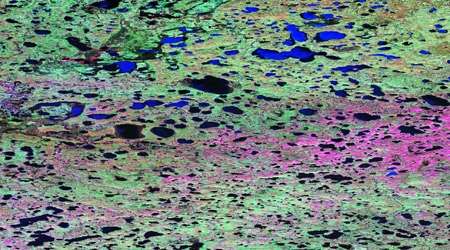The world's lakes have finally been counted

Finland is called 'the land of a thousand lakes'. On registration plates in Minnesota it says '10,000 lakes!', and in Sweden there are about 100,000 lakes. But how many lakes are there in the whole world? New research from Uppsala University gives the answer: there are about 117 million lakes, covering almost four per cent of the world's surface, not counting the glaciers on Greenland and Antarctica.
'If we are to be able to make realistic estimates of the collected effects of the different processes in lakes, for example their contribution to global warming, we first need a good map. We now have that. And it differs significantly from the assumptions previously made regarding the number and size distribution of lakes', says Lars Tranvik, professor of limnology at Uppsala University, who has led the study.
His research group developed a method for finding all lakes down to a size of 0.2 hectares, equivalent to roughly a quarter of a football field. The method was then used on satellite imagery of the whole world to find all lakes, documenting their sizes and shapes. It is the first time all lakes have been counted using a reliable method.
So why do we want to know how many lakes there are? Many research groups, including Lars Tranvik's, study the lakes' roles in the circulation of different substances in nature. Among other things they investigate how microorganisms break down organic compounds into carbon dioxide and methane, which is then released into the atmosphere. As it turns out, lakes contribute significantly to these processes.
'We need to know more about this, not just how molecules and microorganisms work, but also what the total global effect is. Up until now, estimates of global processes have been based on unreliable methods where local measurements have been scaled up', says lead author Charles Verpoorter, currently working at the University of Lille Nord in France.
'The border area between land and water is an important zone for many processes. This study now tells us that the world's lake shores in total are roughly 250 times the length of the equator.'
Charles Verpoorter notes that it was a challenge to develop a method that automatically identifies all lakes in the satellite imagery.
'The challenge was to make it work regardless of the surrounding vegetation, how cloudy the water is, mountain shadows and other things that can be mistaken for water surfaces', he says.
Tiit Kutser, remote analytics expert at the Estonian Marine Institute in Tallinn, was also part of the research team.
'Now we know the location, shape and size of all the world's 117 million lakes down to a fifth of a hectare in size. We believe our database will grow in the future with information about the surrounding lands, hydrology, and more, so that we can get a better understanding of the different water bodies' properties and thereby how they contribute to methane production', he says.
The research has been conducted in a strong research environment financed by the Swedish Research Council Formas, 'Color of Water', which analyses ongoing and future changes in the organic material in lakes, and how this affects production of drinking water as well as the lakes' ecology.
Provided by Uppsala University

















